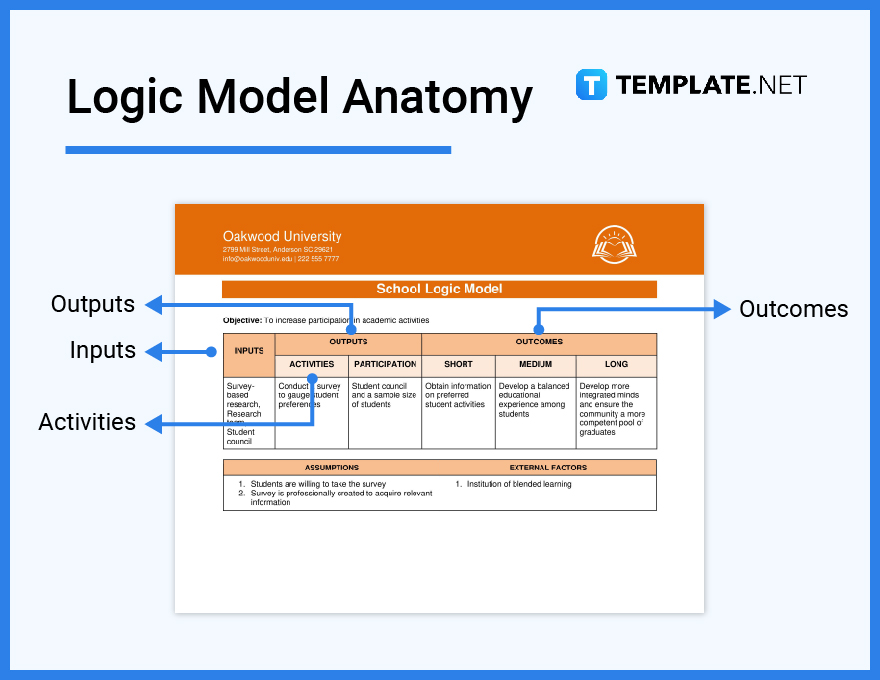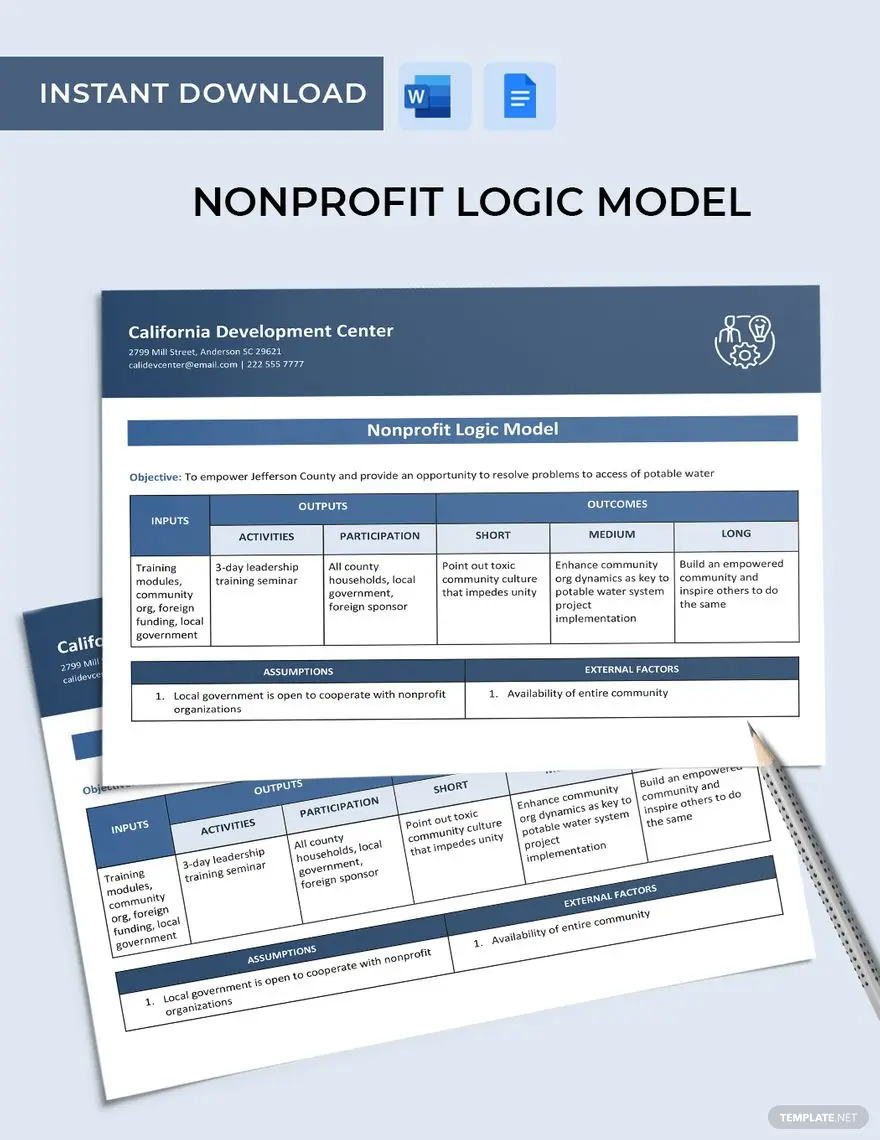Table of Contents
- Logic Model Definition & Meaning
- What Is A Logic Model?
- 10 Types of Logic Model
- Logic Model Uses, Purpose, Importance
- What’s in a Logic Model? Parts?
- How to Design a Logic Model Template?
- Logic Model vs. Strategic Plan
- What’s the Difference Between a Logic Model, Program, and Analytics?
- Logic Model Sizes
- Logic Model Ideas & Examples
- FAQs
Logic Model
Logic models are proposed explanations of the series of factors and outcomes leading to a desired end. They are frequently used to plan, discuss, execute, and assess programs and interventions by organizers, financers, administrators, and evaluators.

Logic Model Definition & Meaning
A logic model includes the shared connections between the program’s inputs, actions, outputs, outcomes, and impacts that are depicted visually.
Logic models are strategy and planning tools that specify the inputs, outputs, and outcomes of a program in order to clarify the reasoning behind program design and demonstrate how particular program activities contribute to desired objectives.
What Is A Logic Model?
A logic model explains how your program or activity should operate and demonstrates why your strategy is a logical solution to the existing problem. Excellent logic models provide a simple and frequently graphic statement of the steps that will bring about change and the results you expect for the community and its people. It keeps everyone in the same direction by providing a consistent language and framework of reference for everyone associated with the project.
10 Types of Logic Model
Education Logic Model
Use the education logic model template to highlight the key components of your program designs. The framework of student intervention programs and curriculum-based activities can be built using this template, among other things. The paper may be created quickly and easily using the template’s prewritten content and user-friendly structure.
Research Logic Model
Use this research logic model template to carry out research activities. You can use this template to construct a summary of your research program, including its goals, sources of data, methods, and results. The template features suggestive language and an intuitive design that are both simple to update for a quick and easy document creation process.
Logic Model of Change
A logic model of change template can be used to design the flow of your program plan. The template includes unique descriptive text that outlines the goals, inputs, outputs, and results of your program logic. It is simple to use and made to display information in an organized manner.
Nonprofit Logic Model
One of the most flexible and practical tools you may have for any nonprofit strategic planning process is a nonprofit logic model. Logic models can be used by your company for a variety of planning processes, including operational resource planning, developing a communications strategy, designing programs and services, and a lot more. In our unique Editor tool, the template’s user-friendly layout is simply modifiable.
School Logic Model
You can produce an overview of your school program plan using the school logic model template. The template has prewritten content so you can clearly and succinctly convey your program’s goals, inputs, outputs, and outcomes. Additionally, it features an intuitive design that is simple to alter for a quick and hassle-free document creation process using our Editor tool, where you can add charts, tables, and illustrations.

Logic Model Uses, Purpose, Importance
A logic model illustrates how your endeavor or effort is expected to function. You may certainly think of a number of applications for the logic model you have created or for which logic modeling would be useful in your work. Your idea to create a successful logic method document may come from knowing the uses, purposes, and significance of logic method.
Sync Up Planning, Execution, and Evaluation
The logic model serves as a complete explanation of your initiative, from resources to results, and is crucial for project planning, implementation, and evaluation. The modeling method forces planners to think more like evaluators. If evaluation is your goal, the modeling stimulates conversation about planning and provides answers to pertinent concerns regarding the management and organization of the job for those who execute.
Prevent Conflicts Between Actions and Results
The vision, mission, objectives, strategies, and action plans of a project are frequently listed in a summary by planners. Even with this knowledge, it could be challenging to determine how everything fits together. A logic model prevents proposing actions with no intended result or predicting consequences without any supporting activities by linking the two.
Facilitates Teamwork
A logic model offers a graphic representation of your project’s underlying theory and major goals. With the help of a well-defined logic model, it is easy to determine where the leads should be handed off from one person or organization to another. This facilitates teamwork and prevents things from slipping through the gaps.
Increasing Effectiveness
Before starting your project, use a logic model to identify any logical flaws or resource constraints. This way, you can establish solutions or take appropriate actions for them. As issues develop during implementation, they can also assist you in identifying areas where adjustments can be made.
Offers Clarity
You can describe your project in detail and with clarity by using the logic model. For those who have a personal or financial stake in their job, this can be quite essential. You can make sure that your logic model is understood by everyone.
What’s in a Logic Model? Parts?
Inputs
All the resources that are actually required to carry out the project are included as inputs. This comprises the quantity of full-time employees and volunteers, their working hours, the money expended, any office space or other real estate, and any tools.
Activities
There are many programs and initiatives that have a plan or timeline in place that describes the major task areas and activities. Refer to the high-level activity regions while deciding which activities to incorporate into the logic model.
Outputs
The project’s offerings and products are considered outputs. This is also an output if the target demographic makes use of these options.
Outcomes
Results at the level of the target groups are called outcomes. They serve as examples of the beneficial changes that the initiative is aiming to bring about in its members.

How to Design a Logic Model Template?
1. Choose a Logic Model Size.
2. Determine the purpose of the logic model document.
3. Choose a Logic Model Template.
4. Write and include all the required parts of the document.
5. Incorporate related graphics, like clipart, icons, images, infographics, and illustrations, then finalize.
6. Download or save the personalized post draft.

Logic Model vs. Strategic Plan
A logic model can verify that the collection of current performance measurements adequately addresses important factors across the performance spectrum.
A strategic plan outlines how an organization will define its strategy or direction and decide how to use its resources to meet its goals.
What’s the Difference Between a Logic Model, Program, and Analytics?
A logic model includes the project’s resources, scheduled activities, deliverables, and goals, which are all represented visually.
A program is a group of related initiatives that are managed together to create benefits that would not be achievable if they were managed separately.
Analytics is the systematic software analysis of data or statistics used to identify, comprehend, and convey key data trends.
Logic Model Sizes
The general procedure of how a program was designed to operate can be presented and explained using logic model templates. Users need to consider the logic model sizes when creating them, especially when these documents are intended for printing.

Logic Model Ideas & Examples
Utilizing a well-designed logic model template would provide a clear visual depiction of all the actions required to bring about a positive transformation. It would unify everyone participating in the process to progress towards a single objective by following the same processes if you presented the employees in your business with these logic model ideas and examples.
- Program Logic Model Ideas and Examples
- Evaluation Logic Model Ideas and Examples
- Project Logic Model Ideas and Examples
- Interactive Logic Model Ideas and Examples
- Outcomes Logic Model Ideas and Examples
- Logic Model Ideas and Examples
- Logic Model Ideas and Examples
- Logic Model Ideas and Examples
- Logic Model Ideas and Examples
- Logic Model Ideas and Examples
FAQs
What should be included in a logic model?
The inputs, activities, outputs, and outcomes should be included in a logic model.
What are the three 3 levels of outcomes in the logic model?
The logic model has three levels of outcomes: level 4, where target groups acquire knowledge, acquire new skills, or alter their attitudes; level 5, where target groups alter their behavior as intended; and level 6, where the target groups’ living circumstances (financially, socially, etc.) change.
What is a simple logic model?
A simple logic model is essentially a methodical and visual means to convey and communicate your understanding of the connections between the tools you have at your disposal to run your program, the actions you want to take, and the modifications or outcomes you wish to achieve.
What makes a good logic model?
Good logic models create a clear, frequently visual declaration of the actions that will effect change and the outcomes you anticipate for the community and its residents.
What is the main goal of an impact logic model?
The goal of the impact logic model is to connect the dots between your organization’s input, output, outcome, and impact.
What are the benefits of developing a logic model?
The advantages of creating and using logic models are that they help program staff gain a shared understanding of how the program functions and their responsibilities to ensure that it functions, and they make it easier to communicate the program to people outside the program in a clear and compelling way.
What is the first step of the logic model?
The gathering of useful data or taking note of project activity is the first step in the logic model process.
When should a logic model be developed?
A logic model may be useful in outlining the many elements, actions, and objectives of a program when creating a new one or determining which portions of an existing program need to be examined.
What are assumptions on a logic model?
A logic model’s assumptions are the presumptions based on theory, research, assessment knowledge, etc., that support the linkages between the model’s elements and are essential to the portfolio, program, or project’s success.
What is a logic model in health promotion?
By illustrating the progression of community transformation, a logic model aids in the work of health promotion and community development.





